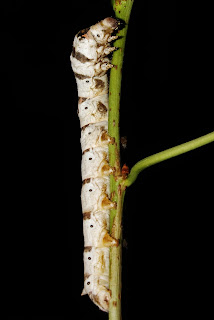
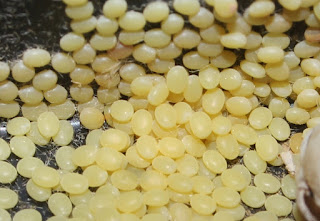
Μεταξοσκώληκας ονομάζεται γενικά η κάμπια του εξημερωμένου είδους Bombyx mori της ομοταξίας των εντόμων. Έχει μεγάλη οικονομική αξία για τον άνθρωπο καθώς εκτρέφεται (σηροτροφία) για την παραγωγή του μεταξιού.Τρέφεται με τα φύλλα της μουριάς.
Morus alba

Εναλλακτική ονομασία του μεταξοσκώληκα στην Κύπρο είναι το καματερόν. Προέρχεται από τη λέξη κάματος που σημαίνει μόχθος, αφού ο συνεχώς εργάζεται παράγοντας το μετάξι.
Το έντομο που προκύπτει από το κουκούλι του μεταξοσκώληκα ονομάζεται πουμπουρία. Οι νεκρές πουμπουρίες που προκύπτουν από το βράσιμο των κουκουλιών αποθηκεύονται και χρησιμοποιούνται ως δόλωμα στο ψάρεμα
Από τη Βικιπαίδεια, την ελεύθερη εγκυκλοπαίδεια
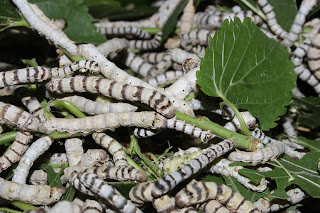
The silkworm is the larva or caterpillar of the domesticated silkmoth, Bombyx mori (Latin: "silkworm of the mulberry tree"). It is an economically important insect, being a primary producer of silk. A silkworm's preferred food is white mulberry leaves (monophagous). Domestic silk moths are closely dependent on humans for reproduction, as a result of millennia of selective breeding. Wild silk moths are different (having not been selectively bred) from their domestic cousins; they are not as commercially viable in the production of silk.

Sericulture, the practice of breeding silkworms for the production of raw silk, has been under way for at least 5,000 years in China, from where it spread to Korea and Japan, India and later the West. The silkworm was domesticated from the wild silkmoth Bombyx mandarina, which has a range from northern India to northern China, Korea, Japan, and the far eastern regions of Russia. The domesticated silkworm derives from Chinese rather than Japanese or Korean stock.
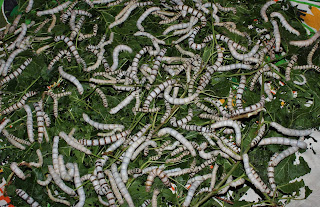
Silkworms were unlikely to have been domestically bred before the Neolithic age; before then, the tools required to facilitate the manufacturing of larger quantities of silk thread had not been developed. The domesticated B. mori and the wild B. mandarina can still breed and sometimes produce hybrids.
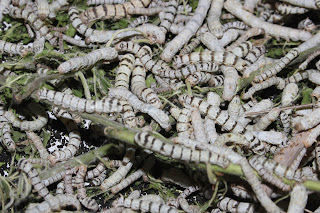
Mulberry silkworms can be categorized into three different but connected groups or types. The major groups of silkworms fall under the univoltine ('uni-'=one, 'voltine'=brood frequency) and bivoltine categories. The univoltine breed is generally linked with the geographical area within greater Europe. The eggs of this type hibernate during winter due to the cold climate, and cross-fertilize only by spring, generating silk only once annually. The second type is called bivoltine and is normally found in China, Japan, and Korea.

The breeding process of this type takes place twice annually, a feat made possible through the slightly warmer climates and the resulting two lifecycles. The polyvoltine type of mulberry silkworm can only be located in the tropics. The eggs are laid by female moths and hatch within nine to 12 days, so the resulting type can have up to eight separate lifecycles throughout the year

Eggs take about 14 days to hatch into larvae, which eat continuously. They have a preference for white mulberry, having an attraction to the mulberry odorant cis-jasmone. They are not monophagous since they can eat other species of Morus, as well as some other Moraceae, mostly Osage orange. Hatchlings and second-instar larvae are called kego and chawki in India. They are covered with tiny black hairs. When the color of their heads turns darker, it indicates they are about to molt. After molting, the instar phase of the silkworms emerge white, naked, and with little horns on their backs.
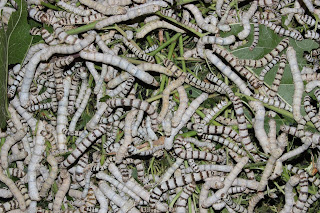
After they have molted four times, their bodies become slightly yellow and the skin becomes tighter. The larvae then prepare to enter the pupal phase of their lifecycle, and enclose themselves in a cocoon made up of raw silk produced by the salivary glands. The final molt from larva to pupa takes place within the cocoon, which provides a vital layer of protection during the vulnerable, almost motionless pupal state. Many other Lepidoptera produce cocoons, but only a few—the Bombycidae, in particular the Bombyx genus, and the Saturniidae, in particular the Antheraea genus—have been exploited for fabric production.

If the animal is allowed to survive after spinning its cocoon and through the pupal phase of its lifecycle, it releases proteolytic enzymes to make a hole in the cocoon so it can emerge as an adult moth. These enzymes are destructive to the silk and can cause the silk fibers to break down from over a mile in length to segments of random length, which seriously reduces the value of the silk threads, but not silk cocoons used as "stuffing" available in China and elsewhere for doonas, jackets etc. To prevent this, silkworm cocoons are boiled. The heat kills the silkworms and the water makes the cocoons easier to unravel. Often, the silkworm itself is eaten.
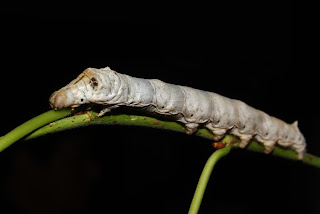
As the process of harvesting the silk from the cocoon kills the larvae, sericulture has been criticized by animal welfare and rights activists. Mohandas Gandhi was critical of silk production based on the Ahimsa philosophy "not to hurt any living thing". This led to Gandhi's promotion of cotton spinning machines, an example of which can be seen at the Gandhi Institute. He also promoted Ahimsa silk, wild silk made from the cocoons of wild and semiwild silk moths. Ahimsa silk is promoted in parts of southern India for those who prefer not to wear silk produced by killing silkworms. Ahimsa silk is also known as peace silk. In the early 21st century, the organization PETA has campaigned against silk.

The moth – the adult phase of the lifecycle – has lost the ability to fly, contrary to the wild B. mandarina, whose males fly to meet females. Silkmoths have a wingspan of 3–5 cm (1.2–2.0 in) and a white, hairy body. Females are about two to three times bulkier than males (for they are carrying many eggs), but are similarly colored. Adult Bombycidae have reduced mouth parts and do not feed, though a human caretaker can feed them.

The cocoon is made of a thread of raw silk from 300 to about 900 m (1,000 to 3,000 ft) long. The fibers are very fine and lustrous, about 10 μm (0.0004 in) in diameter. About 2,000 to 3,000 cocoons are required to make a pound of silk (0.4 kg). At least 70 million pounds of raw silk are produced each year, requiring nearly 10 billion pounds of cocoons.

Due to its miniature size and ease of culture, the silkworm has become a model organism in the study of lepidopteran and arthropod biology. Fundamental findings on pheromones, hormones, brain structures, and physiology have been made with the silkworm.[citation needed] One example of this was the molecular identification of the first known pheromone, bombykol, which required extracts from 500,000 individuals, due to the very small quantities of pheromone produced by any individual worm.

Currently, research is focusing on genetics of silkworms and the possibility of genetic engineering. Many hundreds of strains are maintained, and over 400 Mendelian mutations have been described.[citation needed] Another source suggests 1000 inbred domesticated strains are kept worldwide. One useful development for the silk industry is silkworms that can feed on food other than mulberry leaves, including an artificial diet.[citation needed] Research on the genome also raises the possibility of genetically engineering silkworms to produce proteins, including pharmacological drugs, in the place of silk proteins. Bombyx mori females are also one of the few organisms with homologous chromosomes held together only by the synaptonemal complex (and not crossovers) during meiosis.

Kraig Biocraft Laboratories has used research from the Universities of Wyoming and Notre Dame in a collaborative effort to create a silkworm that is genetically altered to produce spider silk. In September 2010, the effort was announced as successful.

Researchers at Tufts developed scaffolds made of spongy silk that feel and look similar to human tissue. They are implanted during reconstructive surgery to support or restructure damaged ligaments, tendons, and other tissue. They also created implants made of silk and drug compounds which can be implanted under the skin for steady and gradual time release of medications.
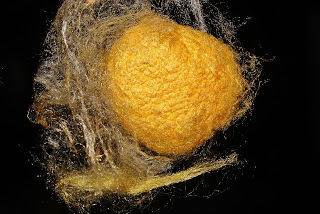
The domesticated variety, compared to the wild form, has increased cocoon size, growth rate, and efficiency of its digestion. It has also gained tolerance to human presence and handling and living in crowded conditions; it cannot fly, so needs human assistance in finding a mate, and it lacks fear of potential predators. These changes have made it entirely dependent upon humans for survival. The eggs are kept in incubators to aid in their hatching.

Silkworms were first domesticated in China over 5000 years ago. Since then, the silk production capacity of the species has increased nearly tenfold. The silkworm is one of the few organisms wherein the principles of genetics and breeding were applied to harvest maximum output. It is next only to maize in exploiting the principles of heterosis and cross breeding.[citation needed]

Silkworm breeding is aimed at the overall improvement of silkworm from an economical point of view. The major objectives are improving fecundity (the egg-laying capacity of a breed), the health of larvae, quantity of cocoon and silk production, disease resistance, etc. Healthy larvae lead to a healthy cocoon crop. Health is dependent on factors such as better pupation rate, fewer dead larvae in the mountage, shorter larval duration (the shorter the larval duration, the lesser the chances of infection) and bluish-tinged fifth-instar larvae (which are healthier than the reddish-brown ones). Quantity of cocoon and silk produced are directly related to the pupation rate and larval weight. Healthier larvae have greater pupation rates and cocoon weights. Quality of cocoon and silk depends on a number of factors including genetics.
Specific purposes apart from commercial purpose are given attention by advanced countries to breed development for specific purposes like sericin production, sex-limited breeds, thin/thick filament production, etc. Disease-resistance breeding is important, as the major reason for crop losses is pathogen infection. Efforts are being made to select breeds which are tolerant or resistant to various pathogens
In the USA, teachers may sometimes introduce the insect lifecycle to their students by raising silkworms in the classroom as a science project. Students have a chance to observe complete lifecycles of insect from egg stage to larvae, pupa, moth.
The silkworm has been raised as a hobby in countries such as China, South Africa, Zimbabwe, and Iran. Children often pass on the eggs, creating a noncommercial population. The experience provides children with the opportunity to witness the lifecycle of silkworms. The practice of raising silkworms by children as pets has, in the nonsilkfarming country of South Africa, led to the development of extremely hardy landraces of silkworms, because they are invariably subjected to hardships not encountered by commercially farmed members of the species. However, these worms, not being selectively bred as such, are possibly inferior in silk production and may exhibit other undesirable traits.
The full genome of the silkworm was published in 2008 by the International Silkworm Genome Consortium. Draft sequences were published in 2004.
The genome of the silkworm is mid-range with a genome size around 432 megabase pairs.
High genetic variability has been found in domestic lines of silkworms, though this is less than that among wild silkmoths (about 83% of wild genetic variation). This suggests a single event of domestication, and that it happened over a short period of time, with a large number of wild worms having been collected for domestication. Major questions, however, remain unanswered: "Whether this event was in a single location or in a short period of time in several locations cannot be deciphered from the data". Research also has yet to identify the area in China where domestication arose
Like many insect species, silkworm pupae are eaten in some cultures.
In Assam, they are boiled for extracting silk and the boiled pupae are eaten directly with salt or fried with chilli pepper or herbs as a snack or dish.
In Korea, they are boiled and seasoned to make a popular snack food known as beondegi번데기.
In China, street vendors sell roasted silkworm pupae.
In Japan, silkworms are usually served as a tsukudani (佃煮), i.e. boiled in a sweet-sour sauce made with soy sauce and sugar.
In Vietnam, this is known as con nhộng.
Silkworms have also been proposed for cultivation by astronauts as space food on long-term mission
From Wikipedia, the free encyclopedia
Photos Geri by George Konstantinou

%20%CE%A4%CE%B7%CF%82%20%CE%BF%CE%B9%CE%BA%CE%BF%CE%B3%CE%B5%CE%BD%CE%B5%CE%AF%CE%B1%CF%82%20%20Crambidae.png)
%20%CE%A4%CE%B7%CF%82%20%CE%BF%CE%B9%CE%BA%CE%BF%CE%B3%CE%B5%CE%BD%CE%B5%CE%AF%CE%B1%CF%82%20Noctuidae%20(1).png)
%20%CE%A4%CE%B7%CF%82%20%CE%BF%CE%B9%CE%BA%CE%BF%CE%B3%CE%B5%CE%BD%CE%B5%CE%AF%CE%B1%CF%82%20Noctuidae%20(2).png)
%20%CE%A4%CE%B7%CF%82%20%CE%BF%CE%B9%CE%BA%CE%BF%CE%B3%CE%B5%CE%BD%CE%B5%CE%AF%CE%B1%CF%82%20Noctuidae%20(3).png)
%20%CE%A4%CE%B7%CF%82%20%CE%BF%CE%B9%CE%BA%CE%BF%CE%B3%CE%B5%CE%BD%CE%B5%CE%AF%CE%B1%CF%82%20Noctuidae%20(4).png)
%20%CE%A4%CE%B7%CF%82%20%CE%BF%CE%B9%CE%BA%CE%BF%CE%B3%CE%B5%CE%BD%CE%B5%CE%AF%CE%B1%CF%82%20Crambidae.png)
%20(Fabricius,%201775)%20%CE%A4%CE%B7%CF%82%20%CE%BF%CE%B9%CE%BA%CE%BF%CE%B3%CE%B5%CE%BD%CE%B5%CE%AF%CE%B1%CF%82%20Pyralidae.png)
%20%CE%A4%CE%B7%CF%82%20%CE%BF%CE%B9%CE%BA%CE%BF%CE%B3%CE%AD%CE%BD%CE%B5%CE%B9%CE%B1%CF%82%20(%CE%A3%CE%B5%CF%83%CE%B9%CE%AF%CE%B4%CE%B5%CF%82)%20Sesiidae%20or%20clearwing%20moths%20(%CE%93%CE%AD%CF%81%CE%B9%2020.6.2006)%20(2).png)
%20%CE%A4%CE%B7%CF%82%20%CE%BF%CE%B9%CE%BA%CE%BF%CE%B3%CE%AD%CE%BD%CE%B5%CE%B9%CE%B1%CF%82%20(%CE%A3%CE%B5%CF%83%CE%B9%CE%AF%CE%B4%CE%B5%CF%82)%20Sesiidae%20or%20clearwing%20moths%20(%CE%93%CE%AD%CF%81%CE%B9%2020.6.2006)%20(1).png)
.JPG)
.JPG)
.JPG)
%20(2)%20-%20Copy.JPG)
%20(2).JPG)
